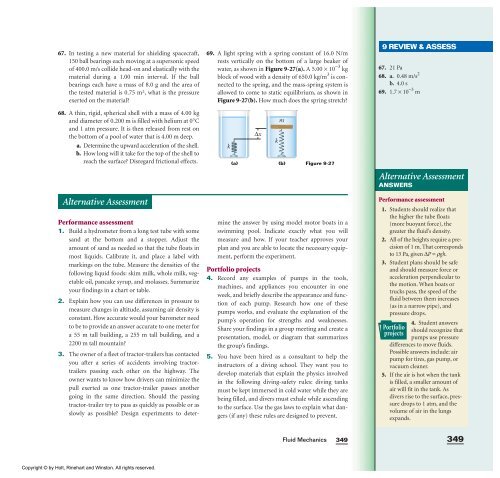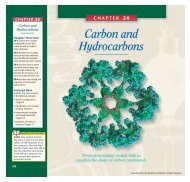You also want an ePaper? Increase the reach of your titles
YUMPU automatically turns print PDFs into web optimized ePapers that Google loves.
67. In testing a new material for shielding spacecraft,<br />
150 ball bearings each moving at a supersonic speed<br />
of 400.0 m/s collide head-on and elastically <strong>with</strong> the<br />
material during a 1.00 min interval. If the ball<br />
bearings each have a mass of 8.0 g and the area of<br />
the tested material is 0.75 m 2, what is the pressure<br />
exerted on the material?<br />
68. A thin, rigid, spherical shell <strong>with</strong> a mass of 4.00 kg<br />
and diameter of 0.200 m is filled <strong>with</strong> helium at 0°C<br />
and 1 atm pressure. It is then released from rest on<br />
the bottom of a pool of water that is 4.00 m deep.<br />
a. Determine the upward acceleration of the shell.<br />
b. How long will it take for the top of the shell to<br />
reach the surface? Disregard frictional effects.<br />
Alternative Assessment<br />
Performance assessment<br />
1. Build a hydrometer from a long test tube <strong>with</strong> some<br />
sand at the bottom and a stopper. Adjust the<br />
amount of sand as needed so that the tube floats in<br />
most liquids. Calibrate it, and place a label <strong>with</strong><br />
markings on the tube. Measure the densities of the<br />
following liquid foods: skim milk, whole milk, vegetable<br />
oil, pancake syrup, and molasses. Summarize<br />
your findings in a chart or table.<br />
2. Explain how you can use differences in pressure to<br />
measure changes in altitude, assuming air density is<br />
constant. How accurate would your barometer need<br />
to be to provide an answer accurate to one meter for<br />
a 55 m tall building, a 255 m tall building, and a<br />
2200 m tall mountain?<br />
3. The owner of a fleet of tractor-trailers has contacted<br />
you after a series of accidents involving tractortrailers<br />
passing each other on the highway. The<br />
owner wants to know how drivers can minimize the<br />
pull exerted as one tractor-trailer passes another<br />
going in the same direction. Should the passing<br />
tractor-trailer try to pass as quickly as possible or as<br />
slowly as possible? Design experiments to deter-<br />
Copyright © by Holt, Rinehart and Winston. All rights reserved.<br />
69. A light spring <strong>with</strong> a spring constant of 16.0 N/m<br />
rests vertically on the bottom of a large beaker of<br />
water, as shown in Figure 9-27(a). A 5.00 × 10 −3 kg<br />
block of wood <strong>with</strong> a density of 650.0 kg/m 3 is connected<br />
to the spring, and the mass-spring system is<br />
allowed to come to static equilibrium, as shown in<br />
Figure 9-27(b). How much does the spring stretch?<br />
k<br />
(a)<br />
∆x<br />
k<br />
m<br />
(b)<br />
Figure 9-27<br />
mine the answer by using model motor boats in a<br />
swimming pool. Indicate exactly what you will<br />
measure and how. If your teacher approves your<br />
plan and you are able to locate the necessary equipment,<br />
perform the experiment.<br />
Portfolio projects<br />
4. Record any examples of pumps in the tools,<br />
machines, and appliances you encounter in one<br />
week, and briefly describe the appearance and function<br />
of each pump. Research how one of these<br />
pumps works, and evaluate the explanation of the<br />
pump’s operation for strengths and weaknesses.<br />
Share your findings in a group meeting and create a<br />
presentation, model, or diagram that summarizes<br />
the group’s findings.<br />
5. You have been hired as a consultant to help the<br />
instructors of a diving school. They want you to<br />
develop materials that explain the physics involved<br />
in the following diving-safety rules: diving tanks<br />
must be kept immersed in cold water while they are<br />
being filled, and divers must exhale while ascending<br />
to the surface. Use the gas laws to explain what dangers<br />
(if any) these rules are designed to prevent.<br />
<strong>Fluid</strong> <strong>Mechanics</strong><br />
349<br />
9 REVIEW & ASSESS<br />
67. 21 Pa<br />
68. a. 0.48 m/s 2<br />
b. 4.0 s<br />
69. 1.7 × 10 −3 m<br />
Alternative Assessment<br />
ANSWERS<br />
Performance assessment<br />
1. Students should realize that<br />
the higher the tube floats<br />
(more buoyant force), the<br />
greater the fluid’s density.<br />
2. All of the heights require a precision<br />
of 1 m. That corresponds<br />
to 13 Pa, given ∆P = rgh.<br />
3. Student plans should be safe<br />
and should measure force or<br />
acceleration perpendicular to<br />
the motion. When boats or<br />
trucks pass, the speed of the<br />
fluid between them increases<br />
(as in a narrow pipe), and<br />
pressure drops.<br />
4. Student answers<br />
Portfolio should recognize that<br />
projects<br />
pumps use pressure<br />
differences to move fluids.<br />
Possible answers include: air<br />
pump for tires, gas pump, or<br />
vacuum cleaner.<br />
5. If the air is hot when the tank<br />
is filled, a smaller amount of<br />
air will fit in the tank. As<br />
divers rise to the surface, pressure<br />
drops to 1 atm, and the<br />
volume of air in the lungs<br />
expands.<br />
349
















